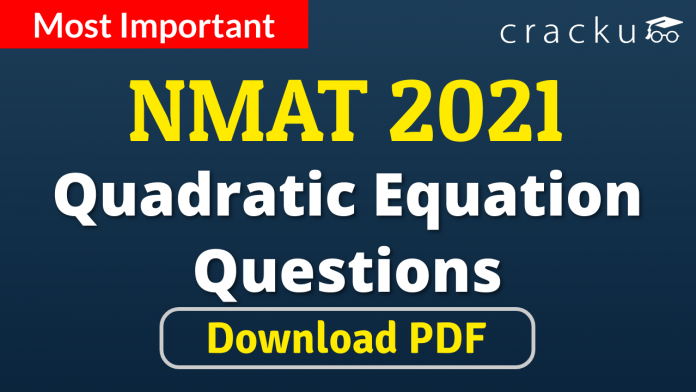Quadratic Equation Questions for NMAT PDF:
Download Quadratic Equation Questions for NMAT PDF. Top 10 very important Quadratic Equation Questions for NMAT based on asked questions in previous exam papers.
Download Quadratic Equation Questions for NMAT
Take NMAT mock test
Question 1: The number of integers that satisfy the equality $(x^{2}-5x+7)^{x+1}=1$ is
a) 3
b) 2
c) 4
d) 5
Question 2: The number of distinct real roots of the equation $(x+\frac{1}{x})^{2}-3(x+\frac{1}{x})+2=0$ equals
Question 3: How many disticnt positive integer-valued solutions exist to the equation $(X^{2}-7x+11)^{(X^{2}-13x+42)}=1$ ?
a) 8
b) 4
c) 2
d) 6
Question 4: If $x^2 + x + 1 = 0$, then $x^{2018} + x^{2019}$ equals which of the following:
a) $x+1$
b) $x$
c) $-x$
d) $x-1$
Question 5: If $U^{2}+(U-2V-1)^{2}$= −$4V(U+V)$ , then what is the value of $U+3V$ ?
a) $0$
b) $\dfrac{1}{2}$
c) $\dfrac{-1}{4}$
d) $\dfrac{1}{4}$
Question 6: If $x+1=x^{2}$ and $x>0$, then $2x^{4}$ is
a) $6+4\sqrt{5}$
b) $3+3\sqrt{5}$
c) $5+3\sqrt{5}$
d) $7+3\sqrt{5}$
Question 7: If $x^{2}$+3x-10is a factor of $3x^{4}+2x^{3}-ax^{2}+bx-a+b-4$ then the closest approximate values of a and b are
a) 25, 43
b) 52, 43
c) 52, 67
d) None of the above
Question 8: If $xy + yz + zx = 0$, then $(x + y + z)^2$ equals
a) $(x + y)^2 + xz$
b) $(x + z)^2 + xy$
c) $x^2 + y^2 + z^2$
d) $2(xy + yz + xz)$
Question 9: If the equation $x^3 – ax^2 + bx – a = 0$ has three real roots, then it must be the case that,
a) b=1
b) b $\neq$ 1
c) a=1
d) a $\neq$ 1
Question 10: If the roots of the equation $x^3 – ax^2 + bx – c = 0$ are three consecutive integers, then what is the smallest possible value of b?[CAT 2008]
a) $\frac{-1}{\sqrt 3}$
b) $-1$
c) $0$
d) $1$
e) $\frac{1}{\sqrt 3}$
Join 7K MBA Aspirants Telegram Group
Download Highly Rated CAT preparation App
Answers & Solutions:
1) Answer (A)
$\left(x^2-5x+7\right)^{x+1}=1$
There can be a solution when $\left(x^2-5x+7\right)=1$ or $x^2-5x\ +6=0$
or x=3 and x=2
There can also be a solution when x+1 = 0 or x=-1
Hence three possible solutions exist.
2) Answer: 1
Let $a=x+\frac{1}{x}$
So, the given equation is $a^2-3a+2=0$
So, $a$ can be either 2 or 1.
If $a=1$, $x+\frac{1}{x}=1$ and it has no real roots.
If $a=2$, $x+\frac{1}{x}=2$ and it has exactly one real root which is $x=1$
So, the total number of distinct real roots of the given equation is 1
3) Answer (D)
$(X^{2}-7x+11)^{(X^{2}-13x+42)}=1$
if $(X^{2}-13x+42)$=0 or $(X^{2}-7x+11)$=1 or $(X^{2}-7x+11)$=-1 and $(X^{2}-13x+42)$ is even number
For X=6,7 the value $(X^{2}-13x+42)$=0
$(X^{2}-7x+11)$=1 for X=5,2.
$(X^{2}-7x+11)$=-1 for X=3,4 and for X=3 or 4, $(X^{2}-13x+42)$ is even number.
.’. {2,3,4,5,6,7} is the solution set of X.
.’. X can take six values.
4) Answer (C)
We know that,
$x^{3} – 1 = (x – 1)(x^{2} + x + 1)$
Since, $x^2 + x + 1 = 0$
$\therefore $ $x^{3} – 1$ = 0
=> $x^{3}$ = 1
Now, $x^{2018} + x^{2019}$
= $(x^{3})^{672} * x^{2}$ + $(x^{3})^{673}$
= $1^{672} * x^{2}$ + $1^{673}$
= $x^{2}$ + 1
= -x
Hence, option C.
5) Answer (C)
Given that $U^{2}+(U-2V-1)^{2}$= −$4V(U+V)$
$\Rightarrow$ $U^{2}+(U-2V-1)(U-2V-1)$= −$4V(U+V)$
$\Rightarrow$ $U^{2}+(U^2-2UV-U-2UV+4V^2+2V-U+2V+1)$ = −$4V(U+V)$
$\Rightarrow$ $U^{2}+(U^2-4UV-2U+4V^2+4V+1)$ = −$4V(U+V)$
$\Rightarrow$ $2U^2-4UV-2U+4V^2+4V+1=−4UV-4V^2$
$\Rightarrow$ $2U^2-2U+8V^2+4V+1=0$
$\Rightarrow$ $2[U^2-U+\dfrac{1}{4}]+8[V^2+\dfrac{V}{2}+\dfrac{1}{16}]=0$
$\Rightarrow$ $2(U-\dfrac{1}{2})^2+8(V+\dfrac{1}{4})^2=0$
Sum of two square terms is zero i.e. individual square term is equal to zero.
$U-\dfrac{1}{2}$ = 0 and $V+\dfrac{1}{4}$ = 0
U = $\dfrac{1}{2}$ and V = $-\dfrac{1}{4}$
Therefore, $U+3V$ = $\dfrac{1}{2}$+$\dfrac{-1*3}{4}$ = $\dfrac{-1}{4}$. Hence, option C is the correct answer.
6) Answer (D)
We know that $x^2 – x – 1=0$
Therefore $x^4 = (x+1)^2 = x^2+2x+1 = x+1 + 2x+1 = 3x+2$
Therefore, $2x^4 = 6x+4$
We know that $x>0$ therefore, we can calculate the value of $x$ to be $\frac{1+\sqrt{5}}{2}$
Hence, $2x^4 = 6x+4 = 3+3\sqrt{5}+4 = 3\sqrt{5}+7$
7) Answer (C)
If $x^{2}$+3x-10is a factor of $3x^{4}+2x^{3}-ax^{2}+bx-a+b-4$
Then x = -5 and x = 2 will give $3x^{4}+2x^{3}-ax^{2}+bx-a+b-4$ = 0
Substituting x = -5 we get,
$3(-5)^{4}+2(-5)^{3}-a(-5)^{2}+b(-5)-a+b-4 = 0$
Solving we get,
$26a+4b = 1621$…….(i)
Substituting x = 2 we get,
$3(2)^{4}+2(2)^{3}-a(2)^{2}+b(2)-a+b-4 =0$
=> $5a-3b = 60$……..(ii)
Solving i and ii we get
a and b $\approx 52, 67$
Hence, option C is the correct answer.
8) Answer (C)
$(x+y+z)^2 = x^2 + y^2 + z^2 + 2(xy + yz + xz)$
as $xy+yz+xz = 0$
so equation will be resolved to $x^2 + y^2 + z^2$
9) Answer (B)
It can be clearly seen that if b=1 then $x^2(x – a) + (x – a) = 0$ an the equation gives only 1 real value of x
10) Answer (B)
b = sum of the roots taken 2 at a time.
Let the roots be n-1, n and n+1.
Therefore, $b = (n-1)n + n(n+1) + (n+1)(n-1) = n^2 – n + n^2 + n + n^2 – 1$
$b = 3n^2 – 1$. The smallest value is -1.
We hope this Quadratic Equation Questions for NMAT pdf for NMAT exam will be highly useful for your Preparation.






![CAT Averages Questions PDF [Important Questions] CAT AVERAGES Questions PDF](https://cracku.in/blog/wp-content/uploads/2022/07/CAT-AVERAGES-Questions-PDF-218x150.png)